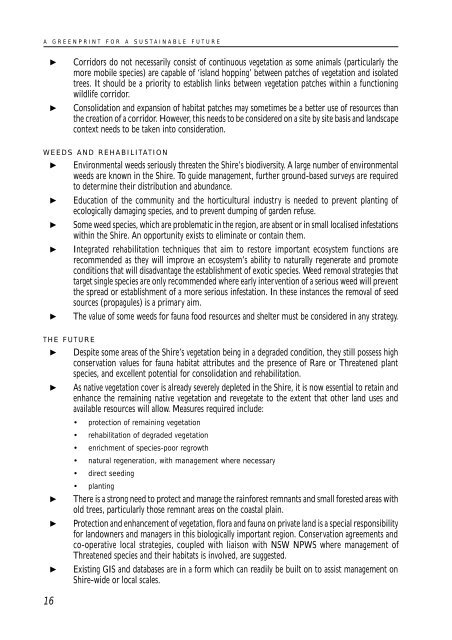Byron Flora and Fauna Study 1999 - Byron Shire Council
Byron Flora and Fauna Study 1999 - Byron Shire Council
Byron Flora and Fauna Study 1999 - Byron Shire Council
Create successful ePaper yourself
Turn your PDF publications into a flip-book with our unique Google optimized e-Paper software.
A GREENPRINT FOR A SUSTAINABLE FUTURE<br />
4 Corridors do not necessarily consist of continuous vegetation as some animals (particularly the<br />
more mobile species) are capable of ‘isl<strong>and</strong> hopping’ between patches of vegetation <strong>and</strong> isolated<br />
trees. It should be a priority to establish links between vegetation patches within a functioning<br />
wildlife corridor.<br />
4 Consolidation <strong>and</strong> expansion of habitat patches may sometimes be a better use of resources than<br />
the creation of a corridor. However, this needs to be considered on a site by site basis <strong>and</strong> l<strong>and</strong>scape<br />
context needs to be taken into consideration.<br />
WEEDS AND REHABILITATION<br />
4 Environmental weeds seriously threaten the <strong>Shire</strong>’s biodiversity. A large number of environmental<br />
weeds are known in the <strong>Shire</strong>. To guide management, further ground-based surveys are required<br />
to determine their distribution <strong>and</strong> abundance.<br />
4 Education of the community <strong>and</strong> the horticultural industry is needed to prevent planting of<br />
ecologically damaging species, <strong>and</strong> to prevent dumping of garden refuse.<br />
4 Some weed species, which are problematic in the region, are absent or in small localised infestations<br />
within the <strong>Shire</strong>. An opportunity exists to eliminate or contain them.<br />
4 Integrated rehabilitation techniques that aim to restore important ecosystem functions are<br />
recommended as they will improve an ecosystem’s ability to naturally regenerate <strong>and</strong> promote<br />
conditions that will disadvantage the establishment of exotic species. Weed removal strategies that<br />
target single species are only recommended where early intervention of a serious weed will prevent<br />
the spread or establishment of a more serious infestation. In these instances the removal of seed<br />
sources (propagules) is a primary aim.<br />
4 The value of some weeds for fauna food resources <strong>and</strong> shelter must be considered in any strategy.<br />
THE FUTURE<br />
4 Despite some areas of the <strong>Shire</strong>’s vegetation being in a degraded condition, they still possess high<br />
conservation values for fauna habitat attributes <strong>and</strong> the presence of Rare or Threatened plant<br />
species, <strong>and</strong> excellent potential for consolidation <strong>and</strong> rehabilitation.<br />
4 As native vegetation cover is already severely depleted in the <strong>Shire</strong>, it is now essential to retain <strong>and</strong><br />
enhance the remaining native vegetation <strong>and</strong> revegetate to the extent that other l<strong>and</strong> uses <strong>and</strong><br />
available resources will allow. Measures required include:<br />
16<br />
• protection of remaining vegetation<br />
• rehabilitation of degraded vegetation<br />
• enrichment of species-poor regrowth<br />
• natural regeneration, with management where necessary<br />
• direct seeding<br />
• planting<br />
4 There is a strong need to protect <strong>and</strong> manage the rainforest remnants <strong>and</strong> small forested areas with<br />
old trees, particularly those remnant areas on the coastal plain.<br />
4 Protection <strong>and</strong> enhancement of vegetation, flora <strong>and</strong> fauna on private l<strong>and</strong> is a special responsibility<br />
for l<strong>and</strong>owners <strong>and</strong> managers in this biologically important region. Conservation agreements <strong>and</strong><br />
co-operative local strategies, coupled with liaison with NSW NPWS where management of<br />
Threatened species <strong>and</strong> their habitats is involved, are suggested.<br />
4 Existing GIS <strong>and</strong> databases are in a form which can readily be built on to assist management on<br />
<strong>Shire</strong>-wide or local scales.

















